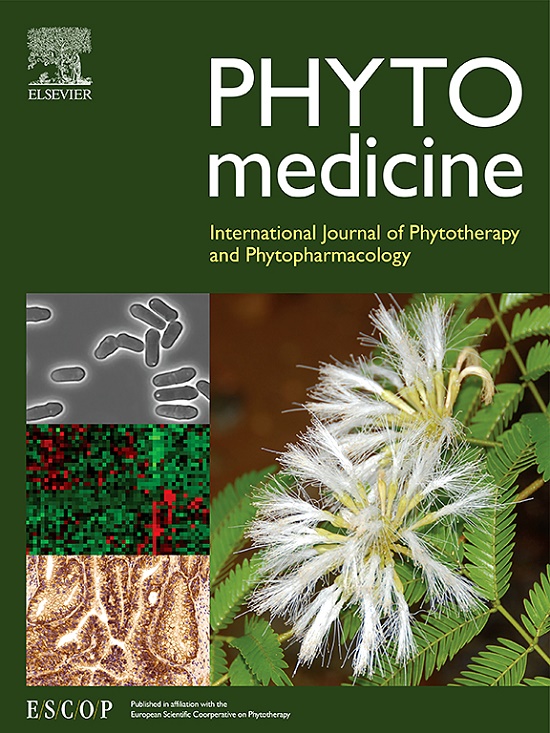Guizhi Shaoyao Zhimu decoction inhibits neutrophil extracellular traps formation to relieve rheumatoid arthritis via gut microbial outer membrane vesicles
IF 6.7
1区 医学
Q1 CHEMISTRY, MEDICINAL
引用次数: 0
Abstract
Background
Rheumatoid arthritis (RA) is a common autoimmune disease with a high disability rate. Accumulating studies suggest that neutrophil extracellular traps (NETs) play a crucial role in the pathogenesis of RA and targeting NETs has emerged as a potential therapeutic strategy for RA. As a traditional Chinese medicine, Guizhi-Shaoyao-Zhimu Decoction (GSZD) has exhibited good efficacy in the treatment of rheumatoid arthritis (RA), while the underly mechanism especially the possibility that GSZD alter NETs formation to relieve RA remains unknown.
Purpose
Our study aimed to investigate relationship between GSZD and NETs in RA treatment and revealed underlying mechanism.
Methods
We constructed collagen-induced arthritis (CIA) model and treated CIA mice with GZSY to validate therapeutic effects of GSZD and examine whether GZSD could inhibit NETs formation in RA. And 16S rRNA sequencing and Fecal microbiota transplantation (FMT) experiment were performed to determine whether GSZD could reduce NETs formation to alleviate RA in gut microbiota-associated manner and identify crucial bacterium in response to GSZD administration. CIA mice treated with effective bacteria and its outer membrane vesicles (OMVs) with oral administration to investigate protective effect against RA and NETs regulative efficiency. We utilized small interfering RNA in vivo and vitro to silence gene mediating effect of GZSD-gut microbiota-NETs.
Results
GSZD could inhibit NETs formation and relive arthritis in CIA mice. Additionally, GSZD alter gut microbiota composition and significantly increase intestinal Parabacteroides goldsteinii (P.goldsteinii) abundance. Mechanistically, P.goldsteinii enriched by GSZD secreted outer membrane vesicles (OMVs) to translocate into joints and activate Cav-1-Nrf2 axis, leading to reduced NETs formation and alleviate arthritis. In clinical, the abundance of P.goldsteinii exhibited negative correlation with NETs indexes and RA disease activities.
Conclusion
Our findings suggest that GSZD inhibits NETs formation to relieve RA in P.goldsteinii-Cav-1-Nrf2 associated manner, which could provide new sight of the prevention and treatment of RA.
桂枝芍药知母汤通过肠道微生物外膜囊泡抑制中性粒细胞胞外捕获物的形成,缓解类风湿性关节炎
背景类风湿性关节炎(RA)是一种常见的自身免疫性疾病,致残率很高。越来越多的研究表明,中性粒细胞胞外捕获物(NETs)在类风湿性关节炎的发病机制中起着至关重要的作用,针对NETs的治疗已成为类风湿性关节炎的一种潜在治疗策略。作为一种传统中药,桂枝芍药知母汤(GSZD)在治疗类风湿性关节炎(RA)方面表现出良好的疗效,但其潜在机制,尤其是桂枝芍药知母汤改变NETs形成以缓解RA的可能性仍不清楚。方法构建胶原诱导的关节炎(CIA)模型,用GZSY治疗CIA小鼠,验证GSZD的治疗效果,并研究GZSD是否能抑制RA中NETs的形成。此外,还进行了16S rRNA测序和粪便微生物群移植(FMT)实验,以确定GSZD是否能通过肠道微生物群相关的方式减少NETs的形成,从而缓解RA,并找出对服用GSZD有反应的关键细菌。通过口服有效细菌及其外膜囊泡(OMVs)治疗 CIA 小鼠,研究其对 RA 的保护作用和 NETs 的调节效率。我们利用体内和体外小干扰 RNA 来沉默 GZSD-肠道微生物群-NETs 的介导基因。此外,GSZD 还能改变肠道微生物群的组成,并显著增加肠道金丝酵母菌(P.goldsteinii)的数量。从机理上讲,GSZD富集的P.goldsteinii会分泌外膜囊泡转运到关节中,激活Cav-1-Nrf2轴,从而减少NETs的形成,缓解关节炎。结论我们的研究结果表明,GSZD通过P.goldsteini-Cav-1-Nrf2相关方式抑制NETs的形成,从而缓解RA,这为RA的预防和治疗提供了新的视角。
本文章由计算机程序翻译,如有差异,请以英文原文为准。
求助全文
约1分钟内获得全文
求助全文
来源期刊

Phytomedicine
医学-药学
CiteScore
10.30
自引率
5.10%
发文量
670
审稿时长
91 days
期刊介绍:
Phytomedicine is a therapy-oriented journal that publishes innovative studies on the efficacy, safety, quality, and mechanisms of action of specified plant extracts, phytopharmaceuticals, and their isolated constituents. This includes clinical, pharmacological, pharmacokinetic, and toxicological studies of herbal medicinal products, preparations, and purified compounds with defined and consistent quality, ensuring reproducible pharmacological activity. Founded in 1994, Phytomedicine aims to focus and stimulate research in this field and establish internationally accepted scientific standards for pharmacological studies, proof of clinical efficacy, and safety of phytomedicines.
 求助内容:
求助内容: 应助结果提醒方式:
应助结果提醒方式:


